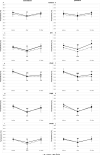The use of thermal imaging for monitoring the training progress of professional male sweep rowers
- PMID: 36192419
- PMCID: PMC9530168
- DOI: 10.1038/s41598-022-20848-7
The use of thermal imaging for monitoring the training progress of professional male sweep rowers
Abstract
This study assesses the thermal profile of the skin in highly trained rowers and investigates the relationship between resting skin temperature (Ts) and the muscle peak torque (PT) measured in statics at the beginning (autumn) and the end (spring) of the preparatory period. Ten professional male sweep rowers, members of the Polish national rowing team, were investigated. A thermal imaging camera was used to analyze the Ts. The PT of the muscles involved in the rowing cycle were measured isometrically. No significant temperature asymmetries were found, except in front of arms after exercise in the spring (p = 0.0228). In contrast, the PT test in the autumn confirmed the significant asymmetry of the knee joint extensors (p = 0.0192). In spring compared to autumn, Ts in many areas of the body were slightly higher, as was PT of underlying muscles. Significant correlations between resting Ts and PT of the underlying muscles were found. Thermal imaging makes it possible to observe changes in skin temperature and symmetry before and after exercise. At this stage, it does not appear to be a method that, without supporting of other methods such as those assessing muscle function, will allow monitoring of training progress.
© 2022. The Author(s).
Conflict of interest statement
The authors declare no competing interests.
Figures




Similar articles
-
Association of cartilage metabolism biomarkers and 25(OH)D levels with muscle biomechanical functions in professional rowers and canoeists.Sci Rep. 2024 Jan 11;14(1):1112. doi: 10.1038/s41598-024-51272-8. Sci Rep. 2024. PMID: 38212477 Free PMC article.
-
Comparison of isokinetic knee torque and bioelectrical activity for hamstrings, quadriceps and erector spinae muscles in elite rowers.Sports Biomech. 2022 Oct;21(9):1082-1092. doi: 10.1080/14763141.2020.1726996. Epub 2020 Mar 6. Sports Biomech. 2022. PMID: 32138614
-
Do sweep rowers symmetrically activate their low back muscles during indoor rowing?Scand J Med Sci Sports. 2015 Aug;25(4):e339-52. doi: 10.1111/sms.12319. Epub 2014 Sep 28. Scand J Med Sci Sports. 2015. PMID: 25264206
-
Rib stress fractures among rowers: definition, epidemiology, mechanisms, risk factors and effectiveness of injury prevention strategies.Sports Med. 2011 Nov 1;41(11):883-901. doi: 10.2165/11593170-000000000-00000. Sports Med. 2011. PMID: 21985212 Review.
-
The physiology of rowing with perspective on training and health.Eur J Appl Physiol. 2020 Sep;120(9):1943-1963. doi: 10.1007/s00421-020-04429-y. Epub 2020 Jul 5. Eur J Appl Physiol. 2020. PMID: 32627051 Review.
Cited by
-
Association of cartilage metabolism biomarkers and 25(OH)D levels with muscle biomechanical functions in professional rowers and canoeists.Sci Rep. 2024 Jan 11;14(1):1112. doi: 10.1038/s41598-024-51272-8. Sci Rep. 2024. PMID: 38212477 Free PMC article.
-
Evaluation of Lower Limb Asymmetry Index Based on the 30-Second Skater Squat Functional Test in Young Men.J Clin Med. 2024 Jul 10;13(14):4017. doi: 10.3390/jcm13144017. J Clin Med. 2024. PMID: 39064057 Free PMC article.
-
Response of skin temperature, blood ammonia and lactate during incremental exercise until exhaustion in elite athletes.Sci Rep. 2024 Jan 26;14(1):2237. doi: 10.1038/s41598-024-52374-z. Sci Rep. 2024. PMID: 38278863 Free PMC article.
-
Thermography in Bike Fitting: A Literature Review.Sensors (Basel). 2025 Apr 8;25(8):2356. doi: 10.3390/s25082356. Sensors (Basel). 2025. PMID: 40285045 Free PMC article. Review.
References
-
- Lin W, Wu J, Chen Z, Li N. Analysis on the physiological and biochemical parameters of weekly pre-competition training session for men’s lightweight rowers. Biomed. J. Sci. Tech. Res. 2019;18:13556–13563.
Publication types
MeSH terms
LinkOut - more resources
Full Text Sources

